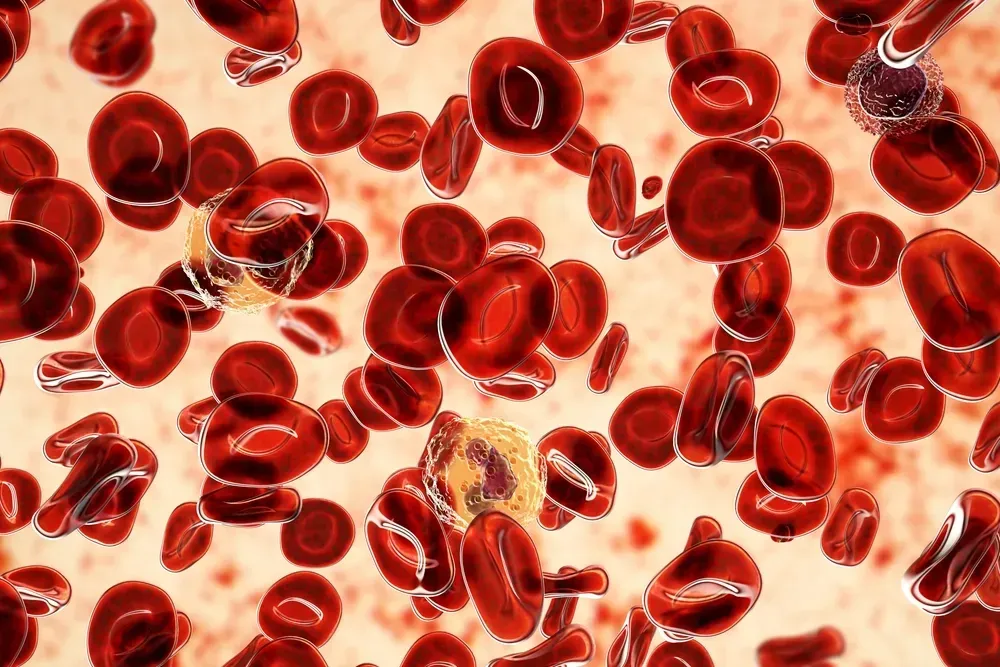How Is Myeloproliferative Neoplasm Diagnosed?
Myeloproliferative neoplasms (MPNs) are a group of diseases that affect blood cell production in the bone marrow. The first step in diagnosing an MPN is a thorough health history and physical exam. Your care team will ask about past illnesses, current symptoms, medications, and family history. While MPNs rarely run in families, some inherited conditions can influence diagnosis and care
What are the Blood Tests for MPNs?
- Complete Blood Count (CBC): This test measures the amount of different types of blood cells in a sample of your blood. People with MPNs often have too many of one type of blood cell and not enough of another.
- Blood Smear: In this test, a blood sample is examined under a microscope to check the shape, size, and number of blood cells. Abnormalities can indicate an MPN.
- Blood chemistry: This test may be indicated to assess the metabolism of blood cells with bilirubin and uric acid, amongst other values. It can also be used to look for inflammation indicators like lactate dehydrogenase.
- Other tests: Erythropoietin levels (a hormone involved in red cell production), and iron studies are also used to help identify the specific type of MPN
What are the Bone Marrow Tests for MPNs?
The bone marrow aspiration and biopsy tests involve taking a small sample of the bone marrow in your hipbone to be examined under a microscope. This test will confirm an MPN diagnosis because, in this condition, the bone marrow is often fibrous and scarred.
What are the Genetic Analysis for MPNs?
The genetic analysis of the abnormal blood or bone marrow cells looks for mutations related to MPN. Your doctor indicates these tests, and each of them is performed differently in a lab, but the sample required can be a blood sample or a bone marrow biopsy. The genetic tests that analyze the fibrous tissue or abnormal blood cells are:
- Immunohistochemistry
- Flow cytometry
- FISH (Fluorescent In Situ Hybridization)
- Karyotype
- Cytogenetics
- NGS (Next Generation Sequencing)
- PCR (Polymerase Chain Reaction)
The goal of these tests is to find out what has caused the scarring tissue to form in the bone marrow and if there aren’t other causes that may explain it after thorough questioning by your doctor. They will determine which tests are more efficient in finding the problem.
Genetic Markers Make the Difference
Most people with an MPN have a genetic mutation in their blood cells. Testing for these changes is a standard part of diagnosis. The most common mutations in MPNs include:
- JAK2 V617F: Found in nearly all people with polycythemia vera and about half of those with essential thrombocythemia or myelofibrosis.
- CALR and MPL mutations: Often found when JAK2 is not present.
- Other tests: May include more advanced panels called next-generation sequencing (NGS) to find additional mutations or predict how the MPN might behave over timempn-patient.
Identifying a mutation helps confirm an MPN diagnosis, and in some cases, it can guide which treatment is chosen.
What are the Imaging Tests for MPNs?
- Ultrasound: This imaging test uses sound waves to create pictures of the inside of your body. It can show whether your spleen or liver is enlarged, which can occur in people with MPNs.
- Computed Tomography (CT) Scan: his test creates detailed pictures of your body. It can help identify any abnormalities in your spleen or liver, and sometimes, it can help determine the extent of bone marrow affected by fibrosis. It can be useful when performing a bone marrow biopsy.
- Magnetic resonance imaging (MRI): Can help to measure the damage in the bone marrow, as it can show the marrow inside bones and the soft tissues around, including blood vessels and nerves.
A Summary of Diagnosing Myeloproliferative Neoplasm
Diagnosing myeloproliferative neoplasms involves a comprehensive evaluation that includes a thorough medical history, physical examination, and a combination of blood tests, bone marrow tests, and imaging tests. These tests help identify abnormal blood cell production and any associated genetic mutations or physical changes in the body. The results of these tests guide the treatment plan and prognosis.
Expanding knowledge for all patients and discovering the best time to start treatment is possible thanks to research. This is why it is very important to continue active research on myelofibrosis so that patients’ outcomes can be improved.
Stay Ahead with the Latest MPN News
Discover breaking research, treatment updates, patient stories, and educational events tailored for the MPN community.
Myeloproliferative neoplasms (MPNs) are a group of diseases that affect blood cell production in the bone marrow. The first step in diagnosing an MPN is a thorough health history and physical exam. Your care team will ask about past illnesses, current symptoms, medications, and family history. While MPNs rarely run in families, some inherited conditions can influence diagnosis and care
What are the Blood Tests for MPNs?
- Complete Blood Count (CBC): This test measures the amount of different types of blood cells in a sample of your blood. People with MPNs often have too many of one type of blood cell and not enough of another.
- Blood Smear: In this test, a blood sample is examined under a microscope to check the shape, size, and number of blood cells. Abnormalities can indicate an MPN.
- Blood chemistry: This test may be indicated to assess the metabolism of blood cells with bilirubin and uric acid, amongst other values. It can also be used to look for inflammation indicators like lactate dehydrogenase.
- Other tests: Erythropoietin levels (a hormone involved in red cell production), and iron studies are also used to help identify the specific type of MPN
What are the Bone Marrow Tests for MPNs?
The bone marrow aspiration and biopsy tests involve taking a small sample of the bone marrow in your hipbone to be examined under a microscope. This test will confirm an MPN diagnosis because, in this condition, the bone marrow is often fibrous and scarred.
What are the Genetic Analysis for MPNs?
The genetic analysis of the abnormal blood or bone marrow cells looks for mutations related to MPN. Your doctor indicates these tests, and each of them is performed differently in a lab, but the sample required can be a blood sample or a bone marrow biopsy. The genetic tests that analyze the fibrous tissue or abnormal blood cells are:
- Immunohistochemistry
- Flow cytometry
- FISH (Fluorescent In Situ Hybridization)
- Karyotype
- Cytogenetics
- NGS (Next Generation Sequencing)
- PCR (Polymerase Chain Reaction)
The goal of these tests is to find out what has caused the scarring tissue to form in the bone marrow and if there aren’t other causes that may explain it after thorough questioning by your doctor. They will determine which tests are more efficient in finding the problem.
Genetic Markers Make the Difference
Most people with an MPN have a genetic mutation in their blood cells. Testing for these changes is a standard part of diagnosis. The most common mutations in MPNs include:
- JAK2 V617F: Found in nearly all people with polycythemia vera and about half of those with essential thrombocythemia or myelofibrosis.
- CALR and MPL mutations: Often found when JAK2 is not present.
- Other tests: May include more advanced panels called next-generation sequencing (NGS) to find additional mutations or predict how the MPN might behave over timempn-patient.
Identifying a mutation helps confirm an MPN diagnosis, and in some cases, it can guide which treatment is chosen.
What are the Imaging Tests for MPNs?
- Ultrasound: This imaging test uses sound waves to create pictures of the inside of your body. It can show whether your spleen or liver is enlarged, which can occur in people with MPNs.
- Computed Tomography (CT) Scan: his test creates detailed pictures of your body. It can help identify any abnormalities in your spleen or liver, and sometimes, it can help determine the extent of bone marrow affected by fibrosis. It can be useful when performing a bone marrow biopsy.
- Magnetic resonance imaging (MRI): Can help to measure the damage in the bone marrow, as it can show the marrow inside bones and the soft tissues around, including blood vessels and nerves.
A Summary of Diagnosing Myeloproliferative Neoplasm
Diagnosing myeloproliferative neoplasms involves a comprehensive evaluation that includes a thorough medical history, physical examination, and a combination of blood tests, bone marrow tests, and imaging tests. These tests help identify abnormal blood cell production and any associated genetic mutations or physical changes in the body. The results of these tests guide the treatment plan and prognosis.
Expanding knowledge for all patients and discovering the best time to start treatment is possible thanks to research. This is why it is very important to continue active research on myelofibrosis so that patients’ outcomes can be improved.
Stay Ahead with the Latest MPN News
Discover breaking research, treatment updates, patient stories, and educational events tailored for the MPN community.
Trending Articles
Get the Latest Myeloproliferative Neoplasm Updates, Delivered to You.
By subscribing to the HealthTree newsletter, you'll receive the latest research, treatment updates, and expert insights to help you navigate your health.
Together we care.
Together we cure.
3x Faster.




